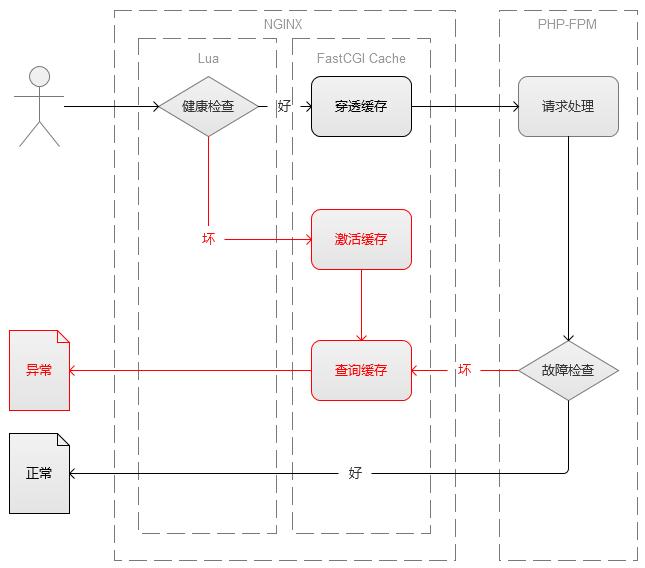在自然界中,很多生物面临生死考验的时候,往往会做出惊人的反应,其中最为大家熟知的当属壁虎,危难关头,与其坐以待毙,不如断尾求生,通过自残来换取活下去的希望。对于互联网项目而言,同样存在着很多生死考验,比如:访问量激增;数据库宕机等等,此时如果没有合理的降级方案,那么结局必然是死路一条。
任何问题一旦脱离了实际情况,便失去了讨论的意义。在继续之前,不妨先介绍一下案例的背景情况:一个PHP网站,以读为主,原本躲在CDN后面,运行很稳定,后来新增了很多强调实时性的需求,便去掉了CDN,进而导致系统稳定性受到影响。因为历史包袱重,所以完全废弃以前的架构显得并不现实,解决方案***能够尽可能透明,不能对原有架构造成冲击,最终我选择了通过FastCGI Cache实现服务降级的方案。
关于FastCGI Cache,以前很多朋友已经做过分享,比如:超群、莿鸟栖草堂,概念性的东西我就不再赘述了,说点与众不同的:虽然使用了缓存,但出于实时性考虑,正常情况下缓存都是被穿透的,只有在出现异常情况的时候才查询,架构图如下:
实现的关键点在于通过error_page处理异常,并且完成服务降级:
- limit_conn_zone $server_name zone=perserver:1m;
- error_page 500 502 503 504 = @degradation;
- fastcgi_cache_path /tmp
- levels=1:2
- keys_zone=degradation:100m
- inactive=10d
- max_size=10g;
- upstream php {
- server 127.0.0.1:9000;
- server 127.0.0.1:9001;
- }
- server {
- listen 80;
- limit_conn perserver 1000;
- server_name *.xip.io;
- root /usr/local/www;
- index index.html index.htm index.php;
- location / {
- try_files $uri $uri/ /index.php$is_args$args;
- }
- location ~ \.php$ {
- set $cache_key $request_method://$host$request_uri;
- set $cache_bypass "1";
- if ($arg_degradation = "on") {
- set $cache_bypass "0";
- }
- try_files $uri =404;
- include fastcgi.conf;
- fastcgi_pass php;
- fastcgi_intercept_errors on;
- fastcgi_next_upstream error timeout;
- fastcgi_cache degradation;
- fastcgi_cache_lock on;
- fastcgi_cache_lock_timeout 1s;
- fastcgi_cache_valid 200 301 302 10h;
- fastcgi_cache_min_uses 10;
- fastcgi_cache_use_stale error
- timeout
- invalid_header
- updating
- http_500
- http_503;
- fastcgi_cache_key $cache_key;
- fastcgi_cache_bypass $cache_bypass;
- add_header X-Cache-Status $upstream_cache_status;
- add_header X-Response-Time $upstream_response_time;
- }
- location @degradation {
- rewrite . $request_uri?degradation=on last;
- }
- }
插播一个小技巧:设置域名时用到了xip.io,有了它就不用设置hosts了,方便调试。
代码里用到的都是Nginx缺省包含的功能,我们可以看作是一个通用版,不过对照我们架构图中的目标就会发现:它没有实现全局激活缓存的功能。如何实现呢?最简单的方法就是通过单位时间内出错次数的多少来判断系统健康以否,设置相应的阈值,一旦超过限制就全局激活缓存,通过Lua我们可以实现一个定制版:
- lua_shared_dict fault 1m;
- limit_conn_zone $server_name zone=perserver:1m;
- error_page 500 502 503 504 = @degradation;
- fastcgi_cache_path /tmp
- levels=1:2
- keys_zone=degradation:100m
- inactive=10d
- max_size=10g;
- upstream php {
- server 127.0.0.1:9000;
- server 127.0.0.1:9001;
- }
- init_by_lua '
- get_fault_key = function(timestamp)
- if not timestamp then
- timestamp = ngx.time()
- end
- return os.date("fault:minute:%M", timestamp)
- end
- get_fault_num = function(timestamp)
- local fault = ngx.shared.fault
- local key = get_fault_key(timestamp)
- return tonumber(fault:get(key)) or 0
- end
- incr_fault_num = function(timestamp)
- local fault = ngx.shared.fault
- local key = get_fault_key(timestamp)
- if not fault:incr(key, 1) then
- fault:set(key, 1, 600)
- end
- end
- ';
- server {
- listen 80;
- limit_conn perserver 1000;
- server_name *.xip.io;
- root /usr/local/www;
- index index.html index.htm index.php;
- location / {
- rewrite_by_lua '
- if ngx.var.arg_degradation then
- return ngx.exit(ngx.OK)
- end
- local ok = true
- for i = 0, 1 do
- local num = get_fault_num(ngx.time() - i * 60)
- if num > 1000 then
- ok = false
- break
- end
- end
- if not ok then
- local query = "degradation=on"
- if ngx.var.args then
- ngxngx.var.args = ngx.var.args .. "&" .. query
- else
- ngx.var.args = query
- end
- end
- ';
- try_files $uri $uri/ /index.php$is_args$args;
- }
- location ~ \.php$ {
- set $cache_key $request_method://$host$request_uri;
- set $cache_bypass "1";
- if ($arg_degradation = "on") {
- set $cache_bypass "0";
- }
- try_files $uri =404;
- include fastcgi.conf;
- fastcgi_pass php;
- fastcgi_intercept_errors on;
- fastcgi_next_upstream error timeout;
- fastcgi_cache degradation;
- fastcgi_cache_lock on;
- fastcgi_cache_lock_timeout 1s;
- fastcgi_cache_valid 200 301 302 10h;
- fastcgi_cache_min_uses 10;
- fastcgi_cache_use_stale error
- timeout
- invalid_header
- updating
- http_500
- http_503;
- fastcgi_cache_key $cache_key;
- fastcgi_cache_bypass $cache_bypass;
- add_header X-Cache-Status $upstream_cache_status;
- add_header X-Response-Time $upstream_response_time;
- }
- location @degradation {
- content_by_lua '
- if ngx.var.arg_degradation then
- return ngx.exit(ngx.HTTP_INTERNAL_SERVER_ERROR)
- end
- local res = ngx.location.capture(
- ngx.var.request_uri, {args = "degradation=on"}
- )
- ngx.status = res.status
- for name, value in pairs(res.header) do
- ngx.header[name] = value
- end
- ngx.print(res.body)
- incr_fault_num()
- ';
- }
- }
说明:实际上真实案例中缓存键名的获取逻辑有点复杂,鉴于篇幅所限一切从简。
当系统正常时,运行于动态模式,数据通过PHP-FPM渲染;当系统异常时,全局缓存被激活,运行于静态模式,数据通过缓存渲染。通过测试发现,系统在从正常切换到异常时,因为舍弃了PHP-FPM,所以RPS从一千跃升到一万。这让我想起儿时看圣斗士的情景:每当不死鸟一辉被敌人击倒后,他总能重新站起来,并爆发出更大的能量。
此外需要说明的是:在发生故障的时候,如果出现大量缓存过期的情况,那么由于涉及到缓存的重建,所以依然会和PHP-FPM发生交互行为,这可能会影响性能,此时没有特别好的解决办法,如果Nginx版本够的话,可以考虑激活fastcgi_cache_revalidate,如此一来,PHP-FPM一旦判断系统处于异常情况,那么可以直接返回304实现缓存续期。
…
通过FastCGI Cache实现服务降级,这是一个***的方案么?非也!它甚至有些丑陋,比如说多台服务器时,会导致大量冗余的缓存,此外磁盘IO也需要注意。虽然这不是一个***的方案,但是它简单,正符合我解决棘手问题时的惯用打法:先用一个土鳖一点的方案缓解问题,再用一个***的方案解决问题。稍后我会考虑使用Memcached,加上一致性哈希来替换FastCGI Cache,实现一个相对***的服务降级方案。



































